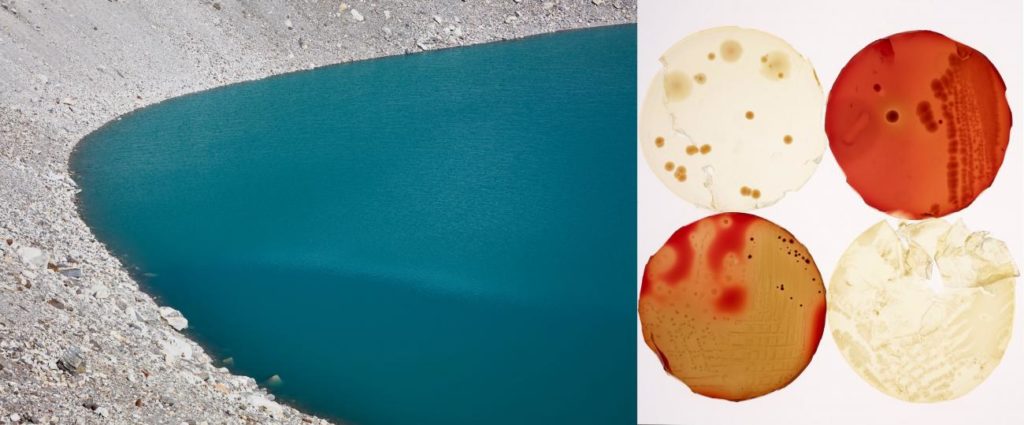
Image: Amph, Nepal, 2016 © Christopher Parsons
Interview with Christopher Parsons by Unseen Amsterdam.
“This year Unseen Amsterdam will be collaborating with Project Pressure to present When Records Melt, an exhibition dedicated to raising environmental awareness through photography. In anticipation of the exhibition, Project Pressure’s Christopher Parsons reflects on his Himalayan expedition—an expedition made possible by his Open Call win—the power of photography and our 21st century consumer society.
How did the experience with Project Pressure change you and your praxis?
The whole experience has been incredibly rewarding. The Himalayan trip showed me first-hand the devastating effect that our 21st century consumer society is having on the planet. Exploring and witnessing the retreating glaciers in the Himalaya region and hearing stories from the locals who have been affected by the drastic changes in the past few decades was truly eye-opening. The locals I met told me about everything from the 2015 earthquakes to how the glaciers are visibly retreating year on year, changing the course of rivers and bringing about flooding. The effect this is all having on their lives is utterly heart-breaking.
I live off-grid on board a narrowboat in and around London so I am already very conscious of my own personal consumption with only solar electricity, a finite supply of fresh water on board, limited waste disposal and limited space. The trip to Nepal highlighted and reinforced my concerns regarding climate change in a very dramatic way—standing in front of a glacier and being told that only 5 years ago it stretched right down to the village in the distance below us was frankly shocking! I want to endeavour to continue to reduce my own personal consumption, but we need change on a much larger scale to combat global warming and I hope this exhibition will help a wider audience see how real and urgent the problem is.
What was the most impressive moment of the expedition?
12:37pm on the 21st of October 2016. In a serene moment of elation I stood alone atop the summit of Chukkung Ri (5558m). It was Day 9 of the expedition and on the previous day I had made an acclimatisation trek up to Imja Glacier (5010m) after recovering from extreme altitude sickness on Day 6. The deep low I experienced with the altitude sickness followed by the extreme high of summiting Chukkung Ri solo, just 3 days later made for a moment that will stay with me for the rest of my life.
On top of the mountain I was surprised to find I had cellular reception, so I made a brief call and spoke with my father and then went on to photograph the two glaciers below me either side of the ridge, Nupste and Lhotse Nupse. These images can be seen at the Unseen Amsterdam exhibition alongside the cultured samples collected from the glaciers.
What did you take away from the collaborations with the scientists of the Glacier Trusts?
Spending over two weeks with nine scientists was a great opportunity for me to not only learn about the mountains and glaciers, but also the effect our irresponsible behaviour is having on the natural environment from a scientific point of view. I had the luxury of a wealth of knowledge that I could call upon throughout the trip and apply this to my work, giving my work a solid scientific basis as well as my own creative input.
The scientists helped with identifying the best vantage points from which to capture the glaciers and helped me to select the best locations to collect the samples that would form the basis of the secondary part of the project back in the UK. It is thanks to their expertise that this project has gone on to become a success, and without them I may not have captured the bacteria for the petri dish images.
Unseen believes in the artist as an investigator. Can photography change the world? What role can photography play in a big issue like climate change?
Photographs have the ability to bring about an instant awareness of a certain situation and inspire people, corporations and even governments to alter their course. Photography can use all mediums, especially the internet, to reach global audiences about issues such as climate change. Images of plastic ridden beaches, and the great pacific garbage patch have already inspired change within companies, communities and consumers. Informed consumers can become a force for good, putting pressure on big corporations to make changes.
My ultimate aim is to encourage the viewer to step back and consider the effect of our irresponsible abuse of natural resources. The juxtaposition of the microscopic beauty against the expansive landscapes, along with the clash of science and art will encourage the viewer to give climate change some thought. I hope that my images along with the work of Project Pressure can become the catalyst to create the positive reaction required to force change.”
